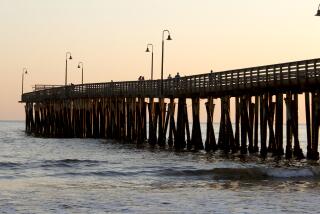Oahu valley families get old-time lease on life : In exchange for living on state land far from Waikiki glitz, they’ll help revive Hawaiian traditions.
- Share via
KAHANA, Hawaii — Cement, cars and asphalt,
and people by the score;
Seems that’s all this home of mine
has come to stand for anymore.
Just when I thought this might be what’s real,
You called me out to feel
Out where the mountains are tall and green
The river is clean and thriving
Out where Oahu feels alive and proud:
Ua nani o (The beautiful rains of) Kahana.
“Kahana’s Song,” by (copyright) Gerald Santos, 1978
*
On the windward side of Oahu, far from the concrete that covers so much of Honolulu, lies a valley whose natural beauty and serenity hark back to the Hawaii of long ago.
The 31 families who live in Kahana Valley will soon begin an unusual experiment. In return for the right to remain on state land, they have agreed to turn their corner of paradise into a “living cultural park,” showcasing native Hawaiian traditions.
The park is supposed to help revive ancient crafts and, with them, basic values of old Hawaii, such as hard work, respect for nature and sharing. At a time when many residents and tourists are seeking an authentic taste of Hawaiian culture, Kahana Valley State Park could offer an alternative to the glitz of Waikiki.
“We cannot find any other example like it anywhere in the world,” said Alfred L. Rogers, park manager. “There was no model to follow.”
In other cultural parks, such as the Colony of Williamsburg, Va., and Old Sturbridge Village, Mass., the craftspeople and guides who re-create a bygone era are paid professionals. They don period dress for their jobs and at the end of the day return to their own homes away from the historic exhibits.
The Hawaiians living in Kahana Valley don’t have that option. Their homes are in the park; their work is a condition of their lease. To remain in the valley, each household must spend 25 hours a month on cultural activities. Residents may raise taro, the Hawaiian staple; weave mats; teach hula; play ukulele, or engage in any of 100 practices identified by the state as distinctly Hawaiian.
Kahana’s concept is looser and more low-key than the historic museum towns. Residents will live their normal lifestyle, reporting to their jobs outside the valley and relying on modern conveniences at home. While working in the park, they may wear what they wish and use updated tools if necessary. Fishermen who throw nets, for example, use monofilament line instead of the natural fibers favored by their ancestors.
Kahana is one of the few remaining valleys on this island that hasn’t been subdivided. In ancient times, its residents worked together, drawing all the necessities of life from the land and the ocean. Today, its tiny population includes blue-collar workers and a state legislator.
Plans for the park date back to the late 1960s, when the state bought the lush 5,000-acre valley and threatened to evict residents to make way for a theme park. Outcry from the public halted those plans. Instead, residents offered to create a living cultural park if they were allowed to stay.
In the ensuing years of bureaucratic hassles, many of the kupuna , or elders, who came up with the idea have died. Some of their children are less enamored of the notion, and a few have openly resisted it. But in December, the state finally recorded 65-year leases with all residents, many of whom trace their roots back generations in the valley.
Lydia Dela Cerna, 79, says she welcomes the chance to help revive her heritage. “I’m glad the state bought the valley,” she said. “I don’t want it destroyed. If some millionaire had it, who knows what would happen?
“To me, the culture is really important--weaving, quilt making, planting sweet potatoes, wrapping fish to cook,” she said. “These things are dying away.”
Other residents say they resent the state’s interference.
“I just don’t like being mandated to do it as a condition of being here,” said Ron Johnson, a firefighter whose grandmother was a hula master. “I’d do it out of aloha (love), not because we had to.”
For the next several months, work requirements have been waived for most residents while they bring their ramshackle homes up to state code. Many are relocating and building anew, with state help. The park schedules a few activities from time to time for visiting school groups, but no one can say when it will be up and running.
For now, visitors stop by the wooden orientation building at the base of the valley to pick up maps of hiking trails. They can make their own way to the remains of a Hawaiian temple and trace the outlines of an ancient fishpond in Kahana’s broad, placid bay.
If they are lucky, they may come across Boy Govida knee-deep in his taro patch, or pounding boiled taro by hand to make poi, the traditional staple. He has made some concessions to modernity. “I put the taro in the Osterizer before I pound it,” he said with a grin.
More to Read
Sign up for The Wild
We’ll help you find the best places to hike, bike and run, as well as the perfect silent spots for meditation and yoga.
You may occasionally receive promotional content from the Los Angeles Times.






